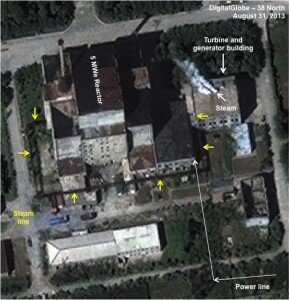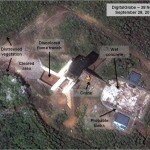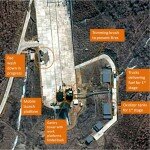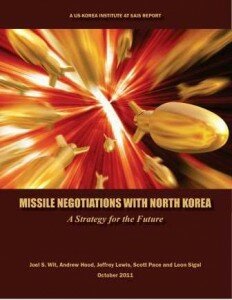Published on September 12, 2013
 The US-Korea Institute at SAIS’s web-journal on North Korea, 38 North, has reported seeing steam emitting from North Korea’s 5 MWe gas-graphite reactor. This reactor, used to produce plutonium for nuclear weapons, was shut down in 1994 as part of the US-North Korea Agreed Framework. In 2008, the cooling tower for the reactor was destroyed as part of the 2007 Six Party Agreement. However, after high tensions on the Korean peninsula earlier this year, North Korea announced its intention to restart this reactor.
The US-Korea Institute at SAIS’s web-journal on North Korea, 38 North, has reported seeing steam emitting from North Korea’s 5 MWe gas-graphite reactor. This reactor, used to produce plutonium for nuclear weapons, was shut down in 1994 as part of the US-North Korea Agreed Framework. In 2008, the cooling tower for the reactor was destroyed as part of the 2007 Six Party Agreement. However, after high tensions on the Korean peninsula earlier this year, North Korea announced its intention to restart this reactor.
38 North analysts have been tracking construction at this site through commercial satellite imagery since the North’s announcement. In DigitalGlobe imagery from August 31, 2013, steam was seen coming from the electrical power generating building. See the full analysis at USKI’s 38 North.
Published on December 14, 2012
USKI’s Joel Wit and Jenny Town published an article on ForeignPolicy.com discussing what the successful North Korean rocket launch means for US foreign policy towards the DPRK. The Obama administration now faces the choice of how his record on North Korea will be remembered: a hard problem more or less contained or a rogue state armed with dozens of nuclear weapons well on its way to threatening the US. Obama’s second term is a second chance to tackle this important foreign policy issue. Is he up to the challenge?
Read the article “Launch This” at ForeignPolicy.com.
Joel Wit is a visiting scholar at the U.S.-Korea Institute at Johns Hopkins School of Advanced International Studies and founder of its North Korea website, 38 North. Jenny Town is a research associate at the U.S.-Korea Institute at Johns Hopkins School of Advanced International Studies and editor of 38 North.
Published on November 14, 2012
 While the North Koreans may have refrained from conducting a nuclear test and subsequent missile tests after their failed rocket launch in April 2012, recent satellite imagery shows that the North is still continuing development of their missile development and the launch pad at the Sohae Satellite Launching Station (Tongchang-ri). USKI’s 38 North was the first to report on these developments, analyzing imagery from DigitalGlobe. According to 38 North analysts, the North has conducted liquid-fueled rocket engine tests at the Sohae facility as recently as September, and has continuing improvements to the Sohae launch pad. Full analysis and satellite imagery can be found here: http://38north.org/2012/11/sohae111212/.
While the North Koreans may have refrained from conducting a nuclear test and subsequent missile tests after their failed rocket launch in April 2012, recent satellite imagery shows that the North is still continuing development of their missile development and the launch pad at the Sohae Satellite Launching Station (Tongchang-ri). USKI’s 38 North was the first to report on these developments, analyzing imagery from DigitalGlobe. According to 38 North analysts, the North has conducted liquid-fueled rocket engine tests at the Sohae facility as recently as September, and has continuing improvements to the Sohae launch pad. Full analysis and satellite imagery can be found here: http://38north.org/2012/11/sohae111212/.
Just after Barack Obama was re-elected to a second term as President of the United States and just a month before a hotly contested presidential race in South Korea, the developments at Sohae have reminded both candidates of why North Korea policy coordination in these new adminstrations is important and of the potential for provocations at the outset of the two Presidents’ terms.
See CNN coverage of the 38 North article here: http://www.cnn.com/video/#/video/world/2012/11/14/clancy-nkorea-rocket-test.cnn.
Published on July 19, 2012
USKI’s 38 North and Stanford University’s Center for International Security and Cooperation (CISAC) have launched new resources on the history of KEDO to help increase public understanding of what this project was and what it accomplished.
When the South Korean fast ferry Hankyoreh sailed out of North Korean waters into the cold wind and waves of the East Sea on the morning of 8 January 2006, it carried a sad and somber group of South Korean workers, ROK officials, and personnel from the Korean Peninsula Energy Development Organization (KEDO). These were all that remained of a decade long multinational effort transforming what in 1994 had been only a paper notion into a modern construction complex of steel and concrete. KEDO’s profile on the North Korean landscape was unmistakable, its impact on Pyongyang profound. Yet, real knowledge and understanding about the organization in public and official circles in South Korea, Japan, and the United States was terribly thin at the beginning, and remains so to this day. ~ A History of KEDO 1994-2006
 In conjunction with the release of CISAC’s new book, A History of KEDO 1994-2006–an oral history project meant to preserve what remains of the living memory about KEDO, of the thinking that went into setting up the organization, the efforts to coordinate plans and translate them to realities on the ground in North Korea, and the struggle to maintain a sense of sanity while KEDO was pushed and pummeled into disintegration–USKI’s 38 North launches a new video: “Reflections on KEDO.” In this video, Joel Wit (38 North founder and Visiting Scholar at the US-Korea Institute at SAIS), hosts a conversation with Ambassador Stephen Bosworth (former US Special Representative for North Korea Policy and current Dean of The Fletcher School at Tufts University) and Robert Carlin (CISAC Visiting Scholar), about their experiences with KEDO. All three were involved with KEDO at different times in its ten year history and provide insights into what it was like on the ground building this multilateral organization. They discuss some of the major challenges in dealing with the North Koreans, as well as the cultural learning curve faced by KEDO’s multicultural staff. From the perspective of direct experience, they examine both KEDO’s accomplishments and the opportunities missed by the organization’s abrupt termination. In the final segment, Ambassador Bosworth also reflects on the Obama administration’s North Korea policy and provides his views on how to improve relations with the North in the future.
In conjunction with the release of CISAC’s new book, A History of KEDO 1994-2006–an oral history project meant to preserve what remains of the living memory about KEDO, of the thinking that went into setting up the organization, the efforts to coordinate plans and translate them to realities on the ground in North Korea, and the struggle to maintain a sense of sanity while KEDO was pushed and pummeled into disintegration–USKI’s 38 North launches a new video: “Reflections on KEDO.” In this video, Joel Wit (38 North founder and Visiting Scholar at the US-Korea Institute at SAIS), hosts a conversation with Ambassador Stephen Bosworth (former US Special Representative for North Korea Policy and current Dean of The Fletcher School at Tufts University) and Robert Carlin (CISAC Visiting Scholar), about their experiences with KEDO. All three were involved with KEDO at different times in its ten year history and provide insights into what it was like on the ground building this multilateral organization. They discuss some of the major challenges in dealing with the North Koreans, as well as the cultural learning curve faced by KEDO’s multicultural staff. From the perspective of direct experience, they examine both KEDO’s accomplishments and the opportunities missed by the organization’s abrupt termination. In the final segment, Ambassador Bosworth also reflects on the Obama administration’s North Korea policy and provides his views on how to improve relations with the North in the future.
My personal conclusion was they [North Koreans] were very serious about what they were doing—the enterprise that we were involved in. This was not something just being done for show. For them, it was not just KEDO and the Agreed Framework and light water reactors, but it was clear for many of them this was important because it was setting a series of precedents for how North Korea could begin to engage with rest of the world in a more direct and active fashion. ~ Ambassador Stephen Bosworth, “Reflections on KEDO,” a 38 North interview
Find the 38 North video here.
Published on March 30, 2012
 New satellite photography reveals that preparations are underway at the Sohae Satellite Launching Station (Tongchang-dong Space Launch Center). 38 North analysts reveal what can be seen in these latest images, and what we can expect to see in the coming days and weeks.
New satellite photography reveals that preparations are underway at the Sohae Satellite Launching Station (Tongchang-dong Space Launch Center). 38 North analysts reveal what can be seen in these latest images, and what we can expect to see in the coming days and weeks.
Published on November 20, 2011
 While public attention has been focused on restarting denuclearization talks with North Korea, an important component of any renewed dialogue with Pyongyang will be controlling its ballistic missile program. That effort has been moving gradually but steadily ahead since the North ended its unilateral test moratorium in 2006 with the further development of threatening technologies, as well as the deployment of new models. Secretary of Defense Robert Gates recently highlighted the dangers posed by this effort during his January trip to Asia. He stated, “With the North Koreans’ continuing development of nuclear weapons and their development of intercontinental ballistic missiles, North Korea is becoming a direct threat to the United States, and we have to take that into account.” growing nuclear weapons stockpile and increasingly capable delivery systems will pose a serious danger to the region, and eventually perhaps even to the United States. In short, if the Six Party Talks resume, a high priority for the United States will be to also start negotiations that cover missiles.
While public attention has been focused on restarting denuclearization talks with North Korea, an important component of any renewed dialogue with Pyongyang will be controlling its ballistic missile program. That effort has been moving gradually but steadily ahead since the North ended its unilateral test moratorium in 2006 with the further development of threatening technologies, as well as the deployment of new models. Secretary of Defense Robert Gates recently highlighted the dangers posed by this effort during his January trip to Asia. He stated, “With the North Koreans’ continuing development of nuclear weapons and their development of intercontinental ballistic missiles, North Korea is becoming a direct threat to the United States, and we have to take that into account.” growing nuclear weapons stockpile and increasingly capable delivery systems will pose a serious danger to the region, and eventually perhaps even to the United States. In short, if the Six Party Talks resume, a high priority for the United States will be to also start negotiations that cover missiles.
read more …
Published on September 15, 2011
 On September 22, 2011, the U.S.-Korea Institute at SAIS, in partnership with Peking University Center for International and Strategic Studies and Chung Ang University Graduate School of International Studies will host a one-day conference exploring the numerous political changes that will take place throughout Asia and the United States in 2012.
On September 22, 2011, the U.S.-Korea Institute at SAIS, in partnership with Peking University Center for International and Strategic Studies and Chung Ang University Graduate School of International Studies will host a one-day conference exploring the numerous political changes that will take place throughout Asia and the United States in 2012.
Panels will discuss what 2012 leadership may look like for the United States, South Korea, Japan, China, Russia and North Korea, as well as what the effects of these changes might have on regional security and security cooperation in the future.
For a full list of speakers and to RSVP, click here.
 The US-Korea Institute at SAIS’s web-journal on North Korea, 38 North, has reported seeing steam emitting from North Korea’s 5 MWe gas-graphite reactor. This reactor, used to produce plutonium for nuclear weapons, was shut down in 1994 as part of the US-North Korea Agreed Framework. In 2008, the cooling tower for the reactor was destroyed as part of the 2007 Six Party Agreement. However, after high tensions on the Korean peninsula earlier this year, North Korea announced its intention to restart this reactor.
The US-Korea Institute at SAIS’s web-journal on North Korea, 38 North, has reported seeing steam emitting from North Korea’s 5 MWe gas-graphite reactor. This reactor, used to produce plutonium for nuclear weapons, was shut down in 1994 as part of the US-North Korea Agreed Framework. In 2008, the cooling tower for the reactor was destroyed as part of the 2007 Six Party Agreement. However, after high tensions on the Korean peninsula earlier this year, North Korea announced its intention to restart this reactor.
 While the North Koreans may have refrained from conducting a nuclear test and subsequent missile tests after their failed rocket launch in April 2012, recent satellite imagery shows that the North is still continuing development of their missile development and the launch pad at the Sohae Satellite Launching Station (Tongchang-ri). USKI’s 38 North was the first to report on these developments, analyzing imagery from DigitalGlobe. According to 38 North analysts, the North has conducted liquid-fueled rocket engine tests at the Sohae facility as recently as September, and has continuing improvements to the Sohae launch pad. Full analysis and satellite imagery can be found here: http://38north.org/2012/11/sohae111212/.
While the North Koreans may have refrained from conducting a nuclear test and subsequent missile tests after their failed rocket launch in April 2012, recent satellite imagery shows that the North is still continuing development of their missile development and the launch pad at the Sohae Satellite Launching Station (Tongchang-ri). USKI’s 38 North was the first to report on these developments, analyzing imagery from DigitalGlobe. According to 38 North analysts, the North has conducted liquid-fueled rocket engine tests at the Sohae facility as recently as September, and has continuing improvements to the Sohae launch pad. Full analysis and satellite imagery can be found here: http://38north.org/2012/11/sohae111212/.
 New satellite photography reveals that preparations are underway at the Sohae Satellite Launching Station (Tongchang-dong Space Launch Center). 38 North analysts reveal what can be seen in these latest images, and what we can expect to see in the coming days and weeks.
New satellite photography reveals that preparations are underway at the Sohae Satellite Launching Station (Tongchang-dong Space Launch Center). 38 North analysts reveal what can be seen in these latest images, and what we can expect to see in the coming days and weeks.

